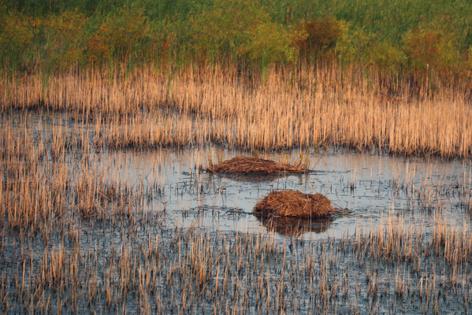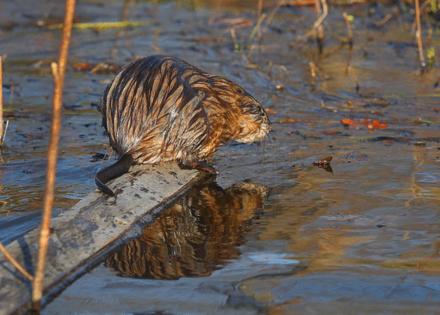Muskrats fight invasive cattails and help restore biodiversity in Great Lakes wetlands, study finds
Published in Science & Technology News
With their surgical nibbles, these large, semi-aquatic, buck-toothed rodents have emerged as crucial helpers for ecologists restoring degraded wetlands across the Great Lakes.
They are not the well-known, dam-building beavers but can often be found in the same marshy ecosystems. Muskrats — which are more closely related to voles and hamsters — love to eat and build their lodges out of invasive cattails.
“One of the first things that happens is the cattail comes in, outcompetes the very diverse community of native plants,” said Shane Lishawa, a researcher at Loyola University Chicago. “And that prevents not only plants, but the aquatic organisms — fish, invertebrates — and then also birds and amphibians from accessing and utilizing these wetlands that are super critical for biodiversity support across the whole region.”
Typha angustifolia, or narrowleaf cattail, was introduced to North America in the dry ballast of European ships during the 19th century. Where it overlaps with the native broadleaf cattail, they produce a hybrid known as Typha x glauca. Lishawa called both the narrowleaf and hybrid cattails “very aggressive wetland invaders.”
While beavers are known for their ability to drastically change their ecosystems, particularly by building dams that regulate water flow, muskrats can substantially alter vegetation structure. They do so by cutting invasive cattails underwater, removing a stem that serves as a snorkel for the plant, allowing it to transfer oxygen from the atmosphere into its roots.
In areas densely packed with tall cattails, muskrats create a “patchwork” of small openings that allow plants of different heights to grow. That, in turn, creates habitat for diverse native wildlife.
It is something Lishawa noticed after years of research in a freshwater marsh on Michigan’s Upper Peninsula, when the local rodent population boomed as decadelong low water levels in the Great Lakes rebounded. The animals, he said, were very apparently “affecting the vegetation — and likely increasing the biodiversity of the site.”
His team shared the observation with their local partners in the Sault Ste. Marie Tribe of Chippewa Indians. “And they were like, ‘Yeah, of course, that’s what muskrats do,'” Lishawa said.
The species holds cultural significance for the Great Lakes Ojibwe Nations, in whose creation stories the common muskrat — Wazhashk in the Indigenous language — plays an important role. Even though it dies in the process, Wazhashk helps restore the Earth after the Great Flood when it retrieves a “little ball of earth” that would later be shaped into Turtle Island, now known as North America.
Equipped with this ecological wisdom, researchers from Loyola, the tribe and the University of Connecticut gathered data and found that muskrats reduced invasive hybrid cattails by 71% where the animals were present in the marsh that connects the Munuscong River with the St. Marys River, located between lakes Superior and Huron.
The removal of the tall plants also reduced the cover of European frogbit, another nonnative plant with floating leaves that Lishawa said likes to grow “in and amongst the cattails.”
“In (the creation) story, Wazhashk’s contribution and sacrifice allowed for others to have a place to live,” the study authors wrote. “(It) illustrates the important role that muskrats play in modifying their environment and providing habitat for other organisms.”
Because muskrats are not present in all wetlands, especially given their population decline in the United States over the last few decades, the researchers also tried to replicate the rodents’ impact on cattails by mowing the plants below the waterline.
“There might be circumstances,” Lishawa said, “where you would like to see the effects of this organism, but you don’t have them there to work with. So, we wanted to see if we could create conditions that reflected what the muskrats did.”
They found that a human management strategy that mimicked the rodent’s cutting method could have a similar effect in reducing the invasive plant’s cover where a muskrat population is not present.
“This is something that I, personally, would like to explore a lot more. I mean, as far as I know, we’re the only people who have ever really tried doing this,” Lishawa said.
Replicating beaver dams has been more widely used in ecosystem restoration, and he hopes mimicking muskrat activity leads to similar success.
“Across North America, there’s been this awakening about the ecological role of beavers,” Lishawa said. “I think that there’s a parallel there with muskrats.”
Beavers are also being live-trapped and moved to where they can help restore degraded ecosystems. Lishawa said there could be potential for a similar effort catching muskrats where they are considered a nuisance and releasing them in natural sites where a population could increase biodiversity or address invasive cattails.
“I think that’s a real possibility, and I think that could definitely help enhance their positive ecological effects,” Lishawa said. To be an effective restoration strategy, it would likely need to be evaluated and implemented on a site-by-site basis.
Under an ambitious restoration plan, Emiquon Nature Preserve wetlands reconnecting to the Illinois River
Enlisting the help of muskrats and imitating them could become part of larger efforts to conserve and restore coastal wetlands, which once spanned more than 1 million acres in the Great Lakes region — but of which only about half remain due to development, drainage for agriculture and other human interventions. Often, remaining wetlands have been degraded by pollution and invasive species.
In Illinois, urban development and agriculture have destroyed as much as 90% of the state’s original marshy, swampy land, including inland and coastal wetlands.
Restoration and conservation work in these ecosystems has become more crucial as federal protections have been challenged in recent years.
The U.S. Supreme Court stripped protections from inland wetlands in the 2023 Sackett v. EPA, allowing private property development where there is no “continuous surface connection” to permanent bodies of water. After the decision, the University of Illinois Urbana-Champaign found that roughly 72% of remaining wetlands in the state are no longer protected by the federal Clean Water Act.
In the case of narrowleaf and hybrid cattails, they have been a part of the landscape for so long that many Americans are unaware their presence in these ecosystems indicates degradation, Lishawa said.
“There’s this concept, in some ecological literature, about shifting baselines,” he said. “Our intuitive sense of what a wetland looks like includes this species that 200 years ago was not there.”
More recent invaders such as frogbit, as well as the common reed, often cause the most concern among conservation scientists due to their dramatic increase over the last few decades. However, the long-standing and often accepted presence of invasive cattails in North America makes addressing the issue all the more challenging.
But Lishawa and his colleagues — Team Typha — want to change that.
Doing so will require more research to evaluate how other organisms respond to the systematic removal of cattails, whether that is by muskrats or humans acting like muskrats.
“Depending on what we find, it could lead to more support for this type of management,” he said.
©2025 Chicago Tribune. Visit at chicagotribune.com. Distributed by Tribune Content Agency, LLC.












Comments